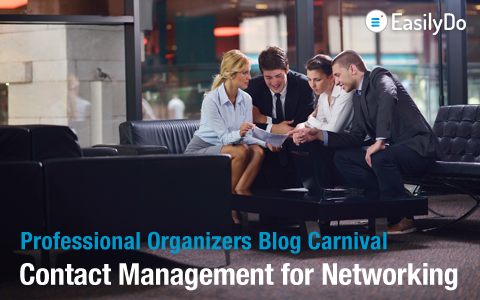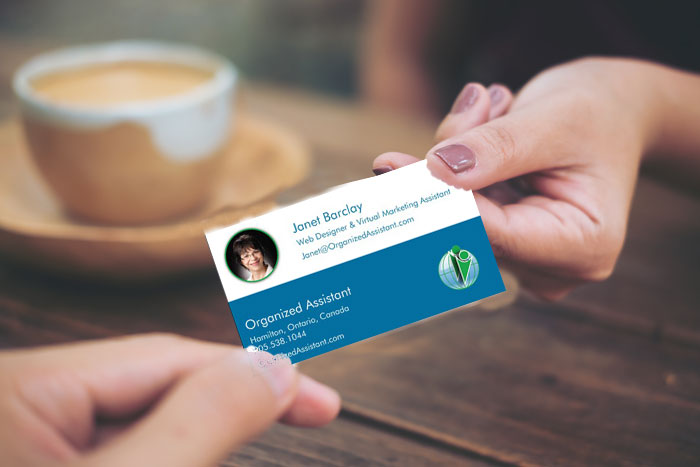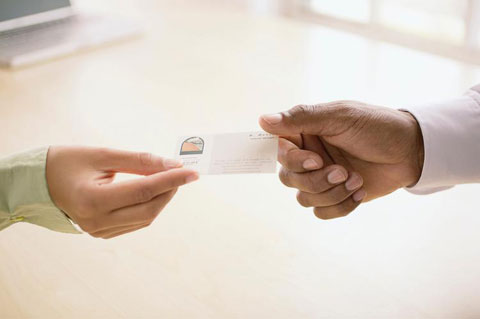Don’t Commit These Networking Faux Pas!
This page may contain links to Amazon.com or other sites from which I may receive commission on purchases you make after clicking on such links. Read my full Disclosure Policy

Today I continue my series for Improve Management Skills Month with a look at networking, both online and offline. Mastering the art of networking will help you to build your brand, expand your reach, grow your business, and be more confident. To determine whether you’re networking effectively, answer the following questions honestly.
1. Do you hand out business cards without even introducing yourself?
Networking is not about one-way advertising; it’s about building and growing relationships. Don’t worry that there isn’t time at a networking event to talk to every other person in attendance – networking is about quality, not quantity.
If there’s someone there that you really want to meet, but they’re engaged in conversation with someone else, patiently wait for your opportunity to talk to them. Don’t just hand them your business card and hope they’ll be so enthralled with it that they’ll look you up. People form relationships with other people, not with business cards.
A better way to make connections is to initiate a conversation and ask for the other person’s card. If they want yours, they’ll ask for it. It might also be appropriate to ask them to email you some additional information about something you discussed, in which case it is perfectly acceptable to give them your business card.
The online equivalent of this faux pas is to send out invitations to connect on LinkedIn without including a personalized note introducing yourself and explaining why you’d like to connect with that person. If you know the person already, it’s probably not as important, but it’s always a nice touch, especially if they may not remember immediately where you’ve met.
Instagram and X are a little different, because you can follow most people without their permission, but if you’re following someone with the hope that they’ll notice and follow you back, you need to try a little harder. Show your admiration and interest by commenting on some of their posts, and share those that will interest your followers.
2. Do you monopolize the conversation?
When you meet someone for the first time, do you talk only about your business, or do you ask about theirs? Even if they offer a product or service you don’t need yourself, it might be useful to someone else you know, and you can do both people a favor by making the connection.
Of course you want to let people know what you offer – that’s one of the goals of networking – but avoid sharing too much information. Watch for visual cues that the other person is getting bored or wanting to get away to talk to others.
Online, make sure that your posts aren’t restricted to announcements about your new blog posts, upcoming events, or other forms of advertising. It’s important to engage with others if you really want to build strong connections.
3. Do you add people to your mailing list without their permission?
It just amazes me how many people think that it’s okay to start sending you their newsletter and/or promotional emails, just because you gave them your business card. I was once at a networking breakfast where during the group discussion, someone mentioned how much this practice annoys them, and I agreed. Despite that, the person sitting next to me added me to her weekly mailing list, and I suspect that she added everyone else that she met too.
Of course, you want to increase your subscriber base, but that’s not the way to go about it. Instead, take one of the following approaches:
- When the person gives you their card, say, “I have a weekly/monthly/occasional newsletter that I send that includes tips about organizing/special offers/information about my upcoming organizing workshops – may I add you to my mailing list?”
- When you get back to your office, email each person you met individually, tell them how much you enjoyed meeting them, and refer to something you discussed. Tell them about your newsletter and invite them to subscribe. Include a copy of a back issue to help them decide whether it’s something that would be of value to them.
When you add people without permission, even if they have the option of unsubscribing easily, you not only risk annoying them, but you put them in the awkward position of not wanting to offend someone they have just met (not to mention that it may be illegal). Is that really how you want to start off a new relationship? Sure, it takes a little more effort to email people personally, but it’s also a lot more effective. Remember: networking is about quality, not quantity.
This is less of an issue online, but I have occasionally had people start sending me their newsletters and e-flyers simply because we’d interacted through a social media platform, and not because I’d signed up for a free e-book or webinar. Just don’t!
4. Do you forget to follow up with the people you meet?
Clearly, by following up, I don’t mean sending them your newsletter. I mean sending them a personal email, or perhaps a card in the mail, to reinforce the connection that you made. This is especially important if you offered to send them information about something.
It’s not about sending them your sales pitch, unless they specifically asked you to do that. If you really want to be remembered, why not send them an article about one of their areas of interest, to show that you were listening?
Online, once you’ve connected with people, make an effort to stay in touch. I realize that your time is valuable and I don’t expect you to send personal messages to everyone all the time. But if someone sends you a message on Facebook, LinkedIn, or another site, take the time to respond. And be sure to acknowledge when someone receives an award or celebrates a birthday or anniversary.
The main thing to remember here is that networking isn’t about going out and getting clients. It’s not even about getting referrals. It’s about knowing the people in your network well enough that when someone asks you, “Do you know anyone who ….. ?” you’ll be able to connect them to someone. That will make people notice you, remember you, and appreciate you, and will ultimately (but not immediately) bring you new business.
Too busy to attend networking events?
Free up time in your schedule by investing in a Website Care Plan! From regular updates to security monitoring and performance optimization, let me handle the technical details so you can get out and make the connections you need to you grow professionally and personally.
Photo by Krakenimages.com / Depositphotos




Janet, this should be required reading for any person just getting started in business networking. I call the people committing error #1 “Drive-By Networkers”, because they’re just “shooting” you a card and moving along. They don’t get that it’s called networking because it takes some work, some effort to build a relationship (whether online or off).
That’s where #2 comes in, and you’ve pegged it! Goodness knows I’m a talker, but the great way to talk in a networking setting is to ask great questions that let the person with whom you’re speaking really shine. They’ll feel good about you if you show genuine interest. As they say, no one cares how much you know until they know how much you care.
As for #3, adding people to an online list without an opt-in isn’t just rude (and an invasion of someone’s personal online space), it’s a violation of the CAN Spam Act of 2003 (15 U.S.C. 7701, et seq., Public Law No. 108-187) in the U.S. It’s so much better if when you’re doing #4 (the great…and apropos) follow-up, if you can say “Hey, that thing you mentioned that’s a problem for you? I wrote an article about it for my newsletter a few months ago and have attached it…I really hope it helps you and if you have questions, I’m here!”
That shows you listened, that you’re offering help, but you’re not filling their mailboxes with something for which they didn’t ask. (Assuming we’re smart in writing our newsletters, there’s a subscription link that works, even if it’s an old issue you’re passing along. People appreciate having the CHOICE as to whether they want to subscribe.)
Great, great post, as always, Janet. Now if only we could get everyone to listen and follow your guidance!
15 years later and ever one of these is still apt. Even though people rarely seem to exchange business cards anymore, we still see those drive-by networkers, so even #1 has stood the test of time, Janet!
Coincidentally, I went to a networking event the same day I posted this. Only one person gave me her business card (which I didn’t ask for, by the way) and I felt like quite the old fuddyduddy offering mine to someone who wanted my contact info.
Thanks, Julie. I really appreciate the time you took to carefully read and respond to my suggestions.
About the subscription link in the newsletter – if by chance you don’t have one, you’ll need to tell people how they can sign up when you send them the sample issue.
Super great tips Janet!
I was added to a mailing list without my permission so I labeled it as spam & sent it back to the email marketing company.
The sender actually PHONED me and told me I was out of line for reporting him as a spammer because he felt that, after speaking to a mutual acquaintance, I would LOVE to receive his newsletter.
This acquaintance obviously wasn’t a “networking shining star” either or she wouldn’t have told him to add me to his mailing list.
I’m with Julie, we need to get everyone to pay attention and follow this great advice!
So Person A told Person B to add you to his mailing list? Wouldn’t a nice email connecting the two of you have been more appropriate? Unbelievable!
These are excellent networking tips!
The newsletter thing is interesting, and maybe this is different. Most people opt-in on their own for my free monthly e-newsletter. And traditionally, I never added anyone without their consent.
However, one of my business connections suggested that I sign up anyone who reaches out to me as a potential client. That’s a slightly different circumstance. The typcial follow-up with emails and calls still are done. But in addition, they would receive more continual and regular follow-up through receiving the newsletter. Your thoughts about that?
Here in Canada, it’s illegal to add anyone to an email list who doesn’t specifically give you permission to do so. I believe in the US you can add people as long as it’s easy for them to unsubscribe, but this may have changed. Here’s a fairly recent blog post from a US law firm that addresses this: Essential Laws Regarding Email Marketing: A Practical Compliance Guide. I hope it’s helpful!
I think I’m doing well on the not giving people stuff they don’t ask for. I spend too much time helping them get rid of stuff to jam up their inboxes and spaces LOL!
I really love your conversation about being patient and listening for what people want. If I have to brashly insert myself into a conversation, odds are they weren’t interested in what I’m offering. I think people remember how you make them feel, so that is my first goal, in networking and just general relating.
Great points, Seana!
Networking is a specialized skill that many people think you only have to be in the room and nothing else matters. Since I am in the decluttering business, I don’t hand out business cards unless someone asks. I do follow people on Linked In after a meeting with a personalized note. I am in a lot of networking meetings that use breakout rooms. I like to see if people make sure everyone gets their fair share of time. It is amazing how many people don’t watch the time. If they are not courteous to other business people, I can’t be sure they will be courteous to my clients.
Thanks for sharing, Julie! You emphasize an important point – networking isn’t all about finding new clients for ourselves. It’s a great way to find potential suppliers for our clients and ourselves, to connect other people we meet who have things in common, and even to make new friends.